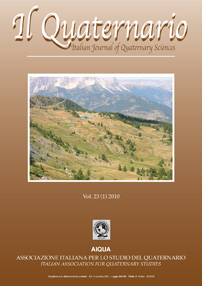Significato paleoclimatico dei rapporti tra il glacialismo principale e quello tributario nella bassa valle della Dora Baltea
Main Article Content
Abstract
Forno M. G., Gianotti F. & Racca G., Palaeoclimatic interpretation of the relations between the main and the tributary glaciers in the lower Dora Baltea Valley (Western Alps). (IT ISSN 0394-3356, 2010).
A detailed geological survey of the low sector of the Dora Baltea Valley and the proximal sector of the Morainic Ivrea Amphitheatre
(AMI) was made, to collect new quaternary geological data in this poorly studied area. Here the bedrock is mainly composed of eclogite mica schist of the the Sesia-Lanzo Zone, part of the Austroalpine System.
The research allows us to reconstruct a glacial terraced succession, preserved in relict limbs and connected with the main valley.
Significant moraines of tributary glaciers (Viona, Chiussuma and Maroncello basins) have also been observed. The various limbs lie on
erosional surfaces shaped in the substratum.
The sedimentologic characters of various glacial and glaciofluvial facies are also described regarding the clast/matrix relation, the
matrix texture, the clast form, the possible stratification, the degree of consolidation of the sediments. The morphologic evidence of
limbs (morainic ridges, kame terraces and limbs without morphological evidence) is also traited.
The sediments linked to the main glacier are prevalently of glacial margin (flow till, glaciofluvial and glaciolacustrine deposits) and,
subordinately, subglacial sediments (lodgement till and melt-out till): they show a significant petrographical variety connected with the
wide Dora Baltea basin. The sediments linked to the tributary glaciers have, instead, a monotonous facies (prevalently marginal flowtill) and a monotonous petrographical composition, limited to local lithotypes.
The morphological expression is more significant for limbs linked to the tributary glaciers (evident lateral and end moraines), compared with the main glacier features, consisting prevalently in thin and discontinuous limb, with a few exceptions of lateral moraines (Gorgiasso, Chanton).
The collected elements allow us to distinguish in the valley sector four alloformations of glacial sediments linked with the main glacier
(Bornasco, Serra, Piverone e Ivrea), referred to the time period of the Middle-Late Pleistocene, already known in the amphitheatre.
The younger alloformation (Af di Ivrea), referred to the Last Glacial Maximum (LGM) and to the subsequent Tardoglacial, is morphostratigraphycally further divided in four allomembers (Andrate, Quintas, Pavone, Prà San Pietro and Torredaniele). These allomembers are connected to the local sequence of LGM glacial stages. The tributary basin deposits are, instead, assembled prevalently in a single alloformation (Trovinasse), referred to the LGM and Tardoglacial, and for the remainder in another allogroup (Rionca), comprising the pre-LGM glacial deposits.
As far as the relation between the main and the tributary glaciers is concerned, various evidence is provided by different sectors. The
morphostratigraphic cross section of the examined area shows the intersection relationship between the tributary glaciers moraines of
the Chiussuma, Maroncello and Viona basins and the main Dora Baltea glacier moraines.
In detail, the end moraines distribution shows that the Chiussuma Glacier reached the valley floor (350 m of elevation) during the LGM:
this glacier connected to the main glacier located in the lower Dora Baltea Valley, after the withdrawal from the Ivrea Morainic
Amphitheatre. The Viona Glacier sediments, referred to LGM, prove, instead, that this glacier has not joined the main glacier in the last
glaciation.
The Maroncello Glacier sediments suggest, finally, that short tributary basins, with scarce elevation and unfavourable exposition, experimented significant glaciers, developed below 1.000 m of elevation and joined the main glacier.
The separation of the Maroncello and Chiussuma Glaciers from the Dora Baltea Glacier happened in the Quintas and Torredaniele
glacial stages, respectively.
For different tributary glaciers, now completely absent, we have calculated the Equilibrium Line Altitude (ELA), using a ratio AAR of
0,67. In the Viona Valley we obtained an ELA of 1.535 m in the main expansion stadial (Andrate); in the Chiussuma Basin the calculated ELA is 1.480 in the Torredaniele stadial; in the short Maroncello glacier the calculated ELA is 1.430 m during the Quintas stadial.
Article Details
Section

This work is licensed under a Creative Commons Attribution-NonCommercial-NoDerivatives 4.0 International License.
The Author grants usage rights to others using an open license (Creative Commons or equivalent) allowing for immediate free access to the work and permitting any user to read, download, copy, distribute, print, search, or link to the full texts of articles, crawl them for indexing, pass them as data to software, or use them for any other lawful purpose.

